The battle of Bir Hakeim
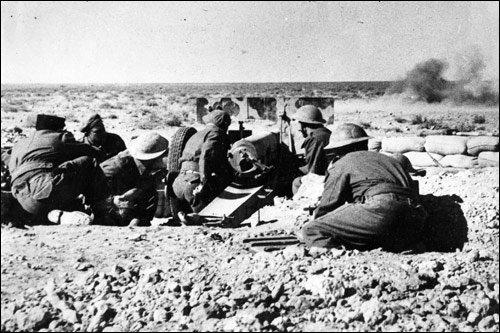
The 1st Free French (France Libre) brigade against the Afrika Korps 26th May - 11th June 1942 From September 1940 onwards, the African continent became the scene of bitter fighting between the Italians and the British. The Italians, actively involved in Libya, were relentless in their conquest of Egypt, under British control at the time. Crushed by the British forces, the Italians received support from German troops.
On the 31st March 1941, General Rommel, at the head of the Afrika Korps, launched his first offensive in Libya. Attacks and counter-attacks followed. At the end of 1941, the British forces commanded by General Auchinleck had reconquered Cyrenaika. Rommel regained the initiative by launching an offensive which should have taken him as far as Tobruk, a maritime relay station and major British base close to the border with Egypt.
The British established a line of resistance running from north to south, which was held in the El Gazala sector in the North by two divisions, one British and the other South African, and in the south by the first brigade of the Free French (1re brigade française libre or BFL), flanked to the east by the 3rd Indian motorised brigade. Minefields stretched from one end to the other.
The mission of the 1st BFL was to hold the southern end of the line of defence. On the orders of General Koenig, they had taken up position in mid-February at Bir Hakeim, situated some 70 kilometres from the Mediterranean coast to the south-west of Tobruk. Bir Hakeim is a former Meharist post built on a dry well on a semi-arid plain at the intersection of several roads. The French position formed a triangle, with a perimeter of about sixteen kilometres, defended by no natural obstacle. It was surrounded by a mine field. The French turned the redoubt into an entrenched camp. Completing the modifications to the site started by the British, they carried out major excavation work, digging trenches and shelters to camouflage men, weapons and vehicles.
In order to stand up to the Germano-Italian troops, the French had anti-tank weapons: 25, 47 and 75 mm canons, anti-aircraft artillery: Bofors AA 40 mm canons and 60 and 81 mm mortars. In addition they had around sixty Bren Carrier light armoured tracked vehicles. The army comprised mainly of two battalions of the Foreign Legion, a marine infantry battalion, the Pacific battalion, the 2nd foot battalion of Oubangui, a North-African company and a company of engineers. The DCA was supported by an English battery. In total, more than three thousand seven hundred men, who received logistical support and air cover from the British.
Rommel's plan was not to carry out a frontal attack on allied positions, but rather to skirt around the line of resistance via the south in order to wage battle from the rear against the British 8th Army. On the 26th May 1942, Italian units launched a diversionary attack on the north and middle of the line of resistance. The following day, a general offensive began. Whilst the Italians launched their tanks on Bir Hakeim, the Germans conducted an encircling manoeuvre to surround and isolate the position by heading back towards the north. The taking of the redoubt should have been no more than a rapidly accomplished formality, but the French reply was brilliant. In one hour, they pushed back the Italians, taking ninety one prisoners. Around thirty enemy tanks remained on the ground. As the Germans continued northwards, where they encountered the British, the French attacked supply convoys and enemy detachments, disrupting communication lines. Rommel, regaining the advantage against the British, decided to reduce this pocket of resistance. The encirclement of the site began on the 2nd June. It was the responsibility of two divisions, one German and the other Italian, supported by groups of artillery and the German air force - the Luftwaffe. Three successive ultimata were issued in vain to the French on the 2nd, 3rd and 5th June.
Aerial bombardments and artillery fire intensified, but the 1st BFL still held out. However, the situation became increasingly precarious as the grip tightened on Bir Hakeim. Rommel came in person to direct operations. The Germano-Italian attacks reached their peak between the 8th and 10th June. Waves of Luftwaffe's aircraft attacked the position, fended off by the Royal Air Force. Evacuation under enemy fire The position was no longer tenable. As the British were now overwhelmed by the German advance, all resistance had become futile. Koenig then ordered a large-scale evacuation on the night of the 10th to 11th June. The 1st BFL forced their way out under fire from the Italo-German lines to meet up with the British lorries waiting for them a few kilometres away, thus avoiding annihilation. They retreated to Egypt with the British, who lost Tobruk on the 21st June.
Some two thousand five hundred men managed to leave, but the fortnight's fighting took its toll. More than a thousand men were killed, wounded or listed missing. The 1st BFL lost fifty two canons and two hundred and fifty vehicles, but inflicted significant material losses on the enemy: fifty one tanks, thirteen armoured cars and several vehicles were destroyed, along with seven aeroplanes. A hundred and twenty three Germans and a hundred and fifty four Italians were taken prisoner. At Bir Hakeim the Free French were confronted by the German military power for the first time and their feat of arms took on a symbolic significance. They stood up to the Italo-German forces, inflicting severe losses. In holding back Rommel and his troops, they checked the German advance, delaying the seizing of Tobruk and, most importantly, allowing the British troops to withdraw. The resistance of the FFL was praised across the English radio network, making the headlines in the allied media. On the 10th June, General de Gaulle sent Koenig a telegram: "You should know and tell your troops that the whole of France is watching you and you are our pride and joy."
| 17th June 1940 | French request for an armistice; departure of General de Gaulle for London. |
| 18th June 1940 | General de Gaulle's appeal to continue the struggle. |
| 22nd June 1940 | Signing of the Franco-German armistice at Rethondes. |
| 24th June 1940 | Signing of the Franco-Italian armistice in Rome. |
| 28th June 1940 | Acknowledgement by Great Britain of General de Gaulle as head of the Free French Forces. |
| 26th - 30th August 1940 | Rallying of Chad, Cameroon, the Middle Congo and Oubangui-Chari to the Free French cause. |
| 12th September 1940 | Italian offensive in Egypt. |
| 23rd -25th Sept. 1940 | Failure outside Dakar of the Anglo-Gaullist attempt to rally French West Africa to the Free French cause. |
| 27th October - 12th Nov. 1940 | Occupation of Gabon by the Free French Forces. |
| 9th December 1940 | British offensive in Libya (operation "Compass"). |
| 19th January - 20th May 1941 | Allied offensive in Italian East Africa. |
| 23rd January 1941 | Taking of Tobruk by the British. |
| 12th February 1941 | Arrival of General Rommel and then the first units of the Deutsche Afrika Korps (on the 14th) in Tripoli. |
| 1st March 1941 | Taking of Al Khofra by Leclerc's Free French. |
| 31st March - 29th April 1941 | Germano-Italian offensive in Libya. |
| 8th June - 14th July 1941 | Anglo-Gaullist campaign in Syria. |
| 18th Nov - 30th Dec. 1941 | British offensive in Libya (operation "Crusader"). |
| 21st January 1942 | Start of Rommel's second offensive in Libya. |
| 14th February 1942 | Arrival of the 1st BFL in Bir Hakeim. |
| end of February - 14th March 1942 | Victorious raid by Leclerc's troops on Fezzan. |
| 26th May 1942 | Start of the Germano-Italian offensive on the Gazala front. |
| 26th May - 11th June 1942 | Battle of Bir Hakeim. |
| 21st June 1942 | Taking of Tobruk by the Germans. |
The 1st light division of the Free French Forces was formed on the 10th May 1941 in Qastina in Palestine. Under the command of General Legentilhomme, it brought together all the groups that had joined the Free French. It was made up of all kinds of units, including most notably the 13th half-brigade of the Foreign Legion who, after participating in the Norway campaign, had reached London in June 1940; the 1st marine infantry battalion, formed in Ismailia, in July 1940, and composed of almost all of the 3rd battalion of the 24th colonial infantry regiment, which had arrived from Cyprus and some foot battalions. Other armies gradually came to complement the original ones. After the Syrian campaign in 1941, it developed into the "Group of divisions of the Free French Forces", comprising the 1st and 2nd light divisions. The 1st light division then became the 1st Free French mixed brigade, which distinguished itself at Bir Hakeim in 1942, whilst the second became the 2nd independent French brigade, distinguishing itself the same year at El Alamein. Bringing together units from the Free French Forces fighting alongside British troops in Libya, the 1st Free French division was created on the 1st February 1943. It became the 1st motorised infantry division in August 1943 and then the 1st foot infantry division in April 1944. In the hearts of war veterans, however, it will always be known as the 1st DFL.
Commanded successively by Generals de Larminat, Koenig, Brosset and Garbay, the division took part in the campaigns in Tunisia (1943), Italy (1944) and France (1944-1945). It was cited four times on the order of the army, in June 1942 (Bir Hakeim) and in January, March and July 1945 (Provence, Alsace, Alps). The 1st DFL was disbanded on the 15th August 1945. Pierre Koenig (Caen 10th October 1898 - Neuilly-sur-Seine 2nd September 1970) After studying at the college of Malherbe in Caen, Pierre Koenig, too young when war was declared in 1914, then enlisted in the infantry in 1917. Appointed mid-shipman in February 1918, he became a sub-lieutenant in September 1918. After the war, he chose a permanent military career. Posted to the Alpine Chasseurs, he served in Silesia from 1919 to 1922 and then with the occupation troops in Germany until 1929. After two years in the 5th infantry regiment in Paris, he served in the Foreign Legion in Morocco. When war was declared in September 1939, Captain Koenig was at military headquarters for the Marrakech region. In February 1940 he left North Africa to take part in the Norwegian campaign with the half-brigade of the Foreign Legion.
On returning to France in June 1940, since the situation did not allow him to carry on the struggle on French soil, he joined General de Gaulle in London. He was thus able to participate in a number of campaigns in which the Free French Forces found themselves involved. He took part in operations in Dakar (September 1940) and Gabon (November 1940). As a Lieutenant Colonel in December 1940 he was appointed Military Commander of Cameroon. Promoted to Colonel a few months later, he took part with the 1st Free French division in the Syrian campaign (1941) and then, appointed Brigade General, fought in Libya (1942) and in Tunisia (1943). He was simultaneously the Superior Commander of the French Forces in Great Britain, the military delegate of the French National Liberation Committee and Commander of the French Home Forces ( Forces françaises de l'intérieur or FFI) in 1944. He later became the military governor and commander of the military region of Paris from 1944 to 1945 and then commander of the French occupying troops in Germany from 1945 to 1949. Made Army General in 1946, he was appointed Inspector of the land, sea and air forces of North Africa in 1949. He then followed a political career, during which he most notably held the post of Minister of Defence in 1954 and again in 1955. Koenig was posthumously elevated to the dignity of Marshal of France in 1984. He held the great Cross of the Légion d'honneur, and was a Companion of the Liberation and Companion of the Order of the Bath. He was also awarded the War Cross1914-1918, the War Cross 1939-1945 and the War Cross for overseas theatres of operations.
The allied forces: The British 8th Army comprised principally the 13th CA (three divisions of infantry, an infantry brigade and two armoured brigades) and the 30th CA (two armoured divisions, an Indian motorised brigade, as well as the 1st BFL), making a total of 125,000 men. In direct opposition with italo-German troops were the South African 1st infantry division, the British 50th infantry division (30th CA) and the 1st BFL which was attached to the 7th armoured division (30th CA). The 1st BFL totalled 5,500 men: the combat echelon entrenched at Bir Hakeim and units located 25 km further east. The British had assembled around 750 tanks and some 700 aircraft. The Germano-Italian forces: The Germans had lined up three divisions (the 15th and 21st armoured divisions and the 90th light division), the Italians two divisions of the 20th CA (the "Ariete" armoured division and the "Trieste" motorised division) as well as the "Sabratha", "Trento" (31st CA), "Brescia" and "Pavia" (10th CA) divisions, making a total of 113,000 men.
The Germano-Italian troops had 570 tanks and 500 aircraft. The strength of the forces at Bir Hakeim, not including the air cover, was estimated to be at a ratio of 3,723 men equipped with around a hundred 25 to 75 mm canons on the Free French side compared to the Italo-Germans' 37,000 men with 270 75 to 210 mm canons (source: the Army museum). Summary From the 26th May to the 11th June 1942, the 1st Free French Brigade stood up to the Afrika Korps and its Italian allies on the Libyan front. It would only disengage from its position at Bir Hakeim after having allowed the withdrawal of British troops.
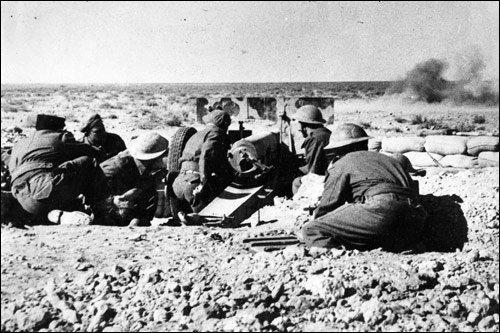
The 1st BFL on the front line. Source: Collection of the Museum of the Order of the Liberation
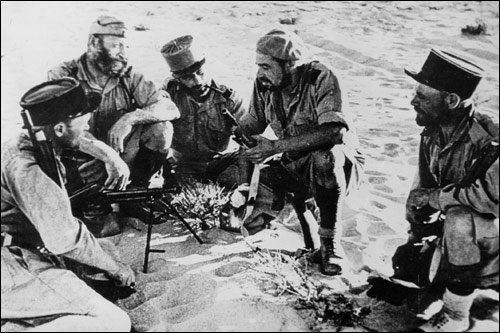
Free French Forces: the war council in the desert before the attack of Bir Hakeim.
Source: Collection of the Museum of the Order of the Liberation
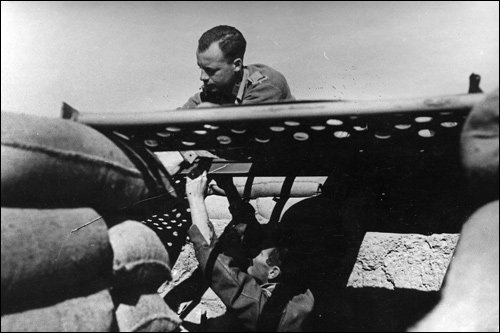
Construction of an individual shelter. Source: Collection of the Museum of the Order of the Liberation
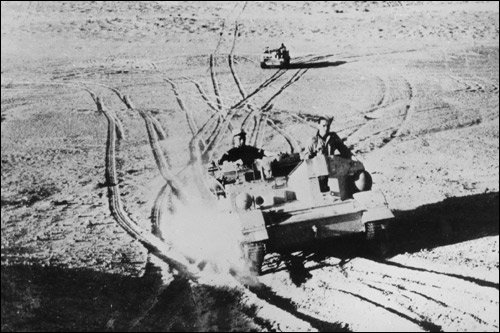
One of the Legion's Bren Carriers on reconnaissance at the beginning of the Bir Hakeim siege in June 1942.
Source: Ministry of Defence's history department
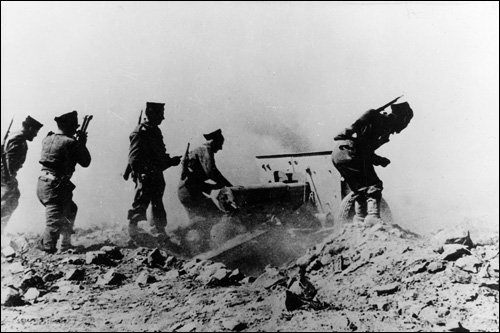
The 1st FFL artillery regiment at Bir Hakeim. Source: Collection of the Museum of the Order of the Liberation
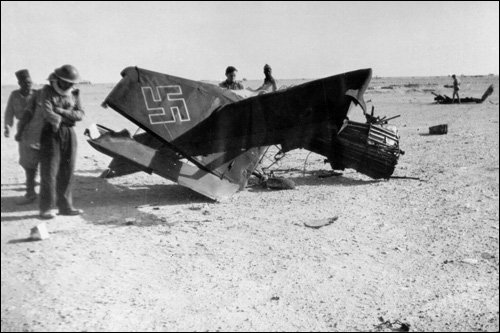
A German aeroplane, shot down by the French at Bir Hakeim. Source: Ministry of Defence's history department
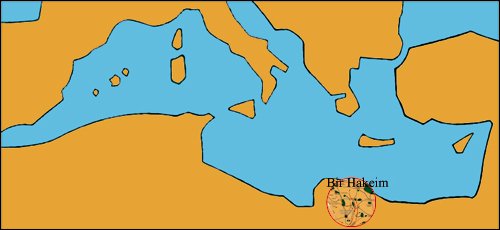
Click on the map to enlarge it
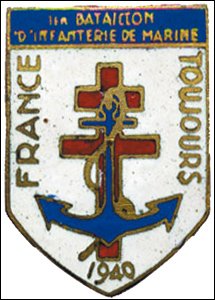
Ensign of the 1st Battalion of Marine Infantry. Source: Ministry of Defence's history department
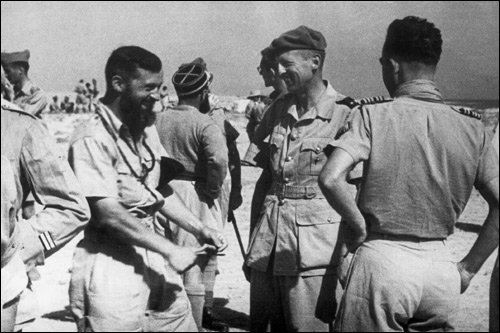
General Koenig with his superior officers at Bir Hakeim. Source: Ministry of Defence's history department
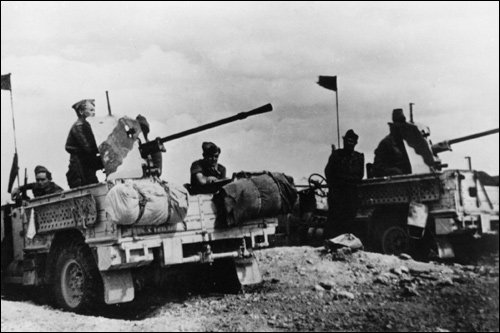
The FFL at Bir Hakeim. Source: Ministry of Defence's history department
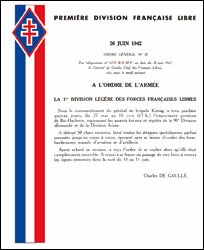
Click on the citation to enlarge it

